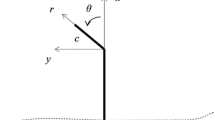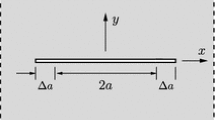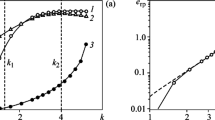Abstract
The purpose of this investigation is to obtain the critical fracture stress, σf, in a cracked elasto-plastic plate subjected to mixed-mode loading. A new model estimating the magnitude of critical fracture stress based on the plastic zone during crack propagation is developed. Subsequently, this concept is applied to predict crack growth due to fatigue loads. Apart from the obvious and ideal benefits of being able to quantify crack propagation rates without the necessity to determine empirical coefficients and exponents experimentally, such an approach would lead to a better understanding of the factors which affect the crack growth rate.
Similar content being viewed by others
References
King A., Ludwig W., Herbig M., Buffière J.-Y., Khan A.A., Stevens N., Marrow T.J.: Three-dimensional in situ observations of short fatigue crack growth in magnesium. Acta Mater. 59(17), 6761–6771 (2011)
Mirsalimov V.M., Rustamov B.E.: Interaction of prefracture zones and crack-visible cavity in a burning solid with mixed boundary conditions. Acta Mech. 223(3), 627–643 (2012)
Souza F.V., Allen D.H.: Modeling the transition of microcracks into macrocracks in heterogeneous viscoelastic media using a two-way coupled multiscale model. Int. J. Solids Struct. 48(22–23), 3160–3175 (2011)
Konstantinos I.: Tserpes strength of graphenes containing randomly dispersed vacancies. Acta Mech. 223(4), 669–678 (2012)
Griffith A.A.: The phenomena of rupture and flow in solids. Trans. R. Soc. Lond. A-221, 163–198 (1920)
Hussain M.A., Pu S.L., Underwood J.: Strain energy release rate for a crack under combined mode I and mode II. Fract. Anal. ASTM STP 560, 2–28 (1974)
Erdogan F., Sih G.C.: On the crack extension in plates under plane loading and transverse shear. ASME J. Basic Eng. 85, 519–527 (1963)
Sih G.C.: Strain–energy–density factor applied to mixed mode crack problems. Int. J. Fract. 10(3), 305–321 (1974)
BS 5447, k 1c Fracture Toughness Testing, British StandardsInstitution (2000)
Paris P.C., Erdogan F.: A critical analysis of crack propagation laws. ASME J. Basic Eng. Ser. D 85, 528–539 (1963)
Cooke R.J., Irving P.E., Booth G.S., Beevers C.J.: The slow fatigue crack growth and threshold behaviour of a medium carbon alloy steel in air and vacuum. Eng. Fract. Mech. 7(1), 69–77 (1975)
Jaubert A., Marigo J.J.: Justification of Paris-type fatigue laws from cohesive forces model via a variational approach. Contin. Mech. Thermodyn. 18(1–2), 23–45 (2006)
Bian L.: Material plasticity dependence of mixed mode fatigue crack growth in commonly used engineering materials. Int. J. Solids Struct. 44(25–26), 8440–8456 (2007)
Bian L., Fawaz Z., Behdinan K.: An improved model for predicting the crack size and plasticity dependence of fatigue crack propagation. Int. J. Fatigue 30(7), 1200–1210 (2008)
Bian L.: Crack growth prediction and non-linear analysis for an elasto-plastic solid. Int. J. Eng. Sci. 47, 325–341 (2009)
Sih, G.C.: Three dimensional crack problems. In: Mechanics of Fracture 2 Noordhoff, Netherlands (1975)
Gillemot L.F.: Criterion of crack initiation and spreading. Eng. Fract. Mech. 8(1), 239–253 (1976)
Irwin G.R.: Linear fracture mechanics. Eng. Fract. Mech. 1, 241–287 (1968)
Liebowitz H., Rice J.R.: Fracture, vol. II. Academic Press, New York (1968)
Schwalbe K.H.: Comparison of several fatigue crack propagation laws with experimental results. Eng. Fract. Mech. 6(2), 325–341 (1974)
Kanazawa T., Machida S., Itoga K.: On the effect of cyclic stress ratio on the fatigue crack propagation. Eng. Fract. Mech. 7(3), 445–455 (1975)
Pilkey W.D.: Formulas for Stress, Strain, and Structural Matrices. A Wiley-Interscience Publication, New York (1994)
Qian J., Fatemi A.: Fatigue crack growth under mixed mode I and II loading. Fatigue Fract. Eng. Mater. Struct. 19(10), 1277–1284 (1996)
Jeong D.Y.: Application of effective stress intensity factor crack closure model to evaluate train load sequence effects on crack growth rates. Theor. Appl. Fract. Mech. 22, 43–50 (1995)
Khen R., Altus E.: Effect of static-mode on fatigue-crack growth by a unified micromechanic model. Mech. Mater. 21(3), 169–189 (1995)
Bulloch J.H.: Effects of mean stress on the threshold fatigue crack extension rates of two spheroidal graphite cast irons. Theor. Appl. Fract. Mech. 18, 15–30 (1992)
Bian L., Taheri F.: A proposed maximum ratio criterion applied to mixed mode fatigue crack propagation. Mater. Des. 32(4), 2066–2072 (2011)
Author information
Authors and Affiliations
Corresponding author
Rights and permissions
About this article
Cite this article
Bian, L., Cheng, Y. & Taheri, F. Elasto-plastic analysis of critical fracture stress and fatigue fracture prediction. Acta Mech 225, 3059–3072 (2014). https://doi.org/10.1007/s00707-014-1102-8
Received:
Revised:
Published:
Issue Date:
DOI: https://doi.org/10.1007/s00707-014-1102-8




